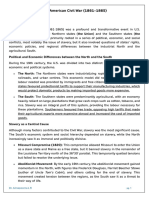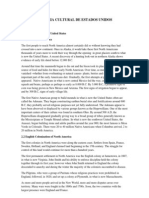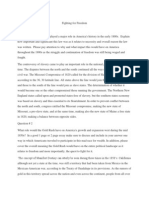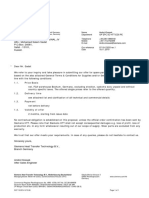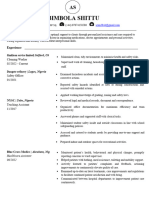CH 26 Sec 3
CH 26 Sec 3
Uploaded by
api-263257778Copyright:
Available Formats
CH 26 Sec 3
CH 26 Sec 3
Uploaded by
api-263257778Original Title
Copyright
Available Formats
Share this document
Did you find this document useful?
Is this content inappropriate?
Copyright:
Available Formats
CH 26 Sec 3
CH 26 Sec 3
Uploaded by
api-263257778Copyright:
Available Formats
758 Chapter 26
MAIN IDEA WHY IT MATTERS NOW TERMS & NAMES
POWER AND AUTHORITY The
United States expanded across
North America and fought a
civil war.
The 20th-century movements to
ensure civil rights for African
Americans and others are a
legacy of this period.
manifest
destiny
Abraham
Lincoln
secede
U.S. Civil War
Emancipation
Proclamation
segregation
3
SETTING THE STAGE The United States won its independence from Britain
in 1783. At the end of the Revolutionary War, the Mississippi River marked the
western boundary of the new republic. As the original United States filled with
settlers, land-hungry newcomers pushed beyond the Mississippi. The govern-
ment helped them by acquiring new territory for settlement. Meanwhile, tensions
between northern and southern states over the issues of states rights and slavery
continued to grow and threatened to reach a boiling point.
Americans Move West
In 1803, President Thomas Jefferson bought the Louisiana Territory from France.
The Louisiana Purchase doubled the size of the new republic and extended its
boundary to the Rocky Mountains. In 1819, Spain gave up Florida to the United
States. In 1846, a treaty with Great Britain gave the United States part of the
Oregon Territory. The nation now stretched from the Atlantic to the Pacific oceans.
Manifest Destiny Many Americans believed in manifest destiny, the idea that
the United States had the right and duty to rule North America from the Atlantic
Ocean to the Pacific Ocean. Government leaders used manifest destiny to justify
evicting Native Americans from their tribal lands.
The Indian Removal Act of 1830 made such actions official policy. This law
enabled the federal government to force Native Americans living in the East to
move to the West. Georgias Cherokee tribe challenged the law before the
Supreme Court. The Court, however, ruled that the suit was not valid. The
Cherokees had to move. Most of them traveled 800 miles to Oklahoma, mainly
on foot, on a journey later called the Trail of Tears. About a quarter of the
Cherokees died on the trip. A survivor recalled how the journey began:
P R I MA R Y S O U R C E
The day was bright and beautiful, but a gloomy thoughtfulness was depicted in the
lineaments of every face. . . . At this very moment a low sound of distant thunder fell
on my ear . . . and sent forth a murmur, I almost thought a voice of divine indignation
for the wrong of my poor and unhappy countrymen, driven by brutal power from all
they loved and cherished in the land of their fathers.
WILLIAM SHOREY COODEY, quoted in The Trail of Tears
War and Expansion
in the United States
Following Chronological
Order Create a time line
to record major events of
the United States in the
19th century.
TAKING NOTES
Event
two
Event
four
Event
one
Event
three
Page 1 of 4
When the Cherokees reached their des-
tination, they ended up on land inferior to
that which they had left. As white settlers
moved west during the 19th century, the
government continued to push Native
Americans off their land.
Texas Joins the United States When
Mexico had gained its independence
from Spain in 1821, its territory included
the lands west of the Louisiana Purchase.
With Mexicos permission, American set-
tlers moved into the Mexican territory of
Texas. However, settlers were unhappy
with Mexicos rule.
In 1836, Texans revolted against
Mexican rule and won their indepen-
dence. Then, in 1845, the United States
annexed Texas. Since Mexico still
claimed Texas, it viewed this annexation
as an act of war.
War with Mexico Between May 1846
and February 1848, war raged between
the two countries. Finally, Mexico sur-
rendered. As part of the settlement of the
Mexican-American War, Mexico ceded
territory to the United States. The
Mexican Cession included California and a huge area in the Southwest. In 1853,
the Gadsden Purchase from Mexico brought the lower continental United States to
its present boundaries.
Civil War Tests Democracy
Americas westward expansion raised questions about what laws and customs
should be followed in the West. Since the nations early days, the northern and
southern parts of the United States had followed different ways of life. Each section
wanted to extend its own way of life to the new territories and states in the West.
North and South The North had a diversified economy, with both farms and
industry. For both its factories and farms, the North depended on free workers. The
Souths economy, on the other hand, was based on just a few cash crops, mainly
cotton. Southern planters relied on slave labor.
The economic differences between the two regions led to a conflict over slavery.
Many Northerners considered slavery morally wrong. They wanted to outlaw slav-
ery in the new western states. Most white Southerners believed slavery was neces-
sary for their economy. They wanted laws to protect slavery in the West so that they
could continue to raise cotton on the fertile soil there.
The disagreement over slavery fueled a debate about the rights of the individual
states against those of the federal government. Southern politicians argued that the
states had freely joined the Union, and so they could freely leave. Most
Northerners felt that the Constitution had established the Union once and for all.
Civil War Breaks Out Conflict between the North and South reached a climax in
1860, when Abraham Lincoln was elected president. Southerners fiercely
An Age of Democracy and Progress 759
Contrasting
What were the
main economic dif-
ferences between
the Northern and
Southern states?
20N
40N
6
0
N
1
0
0
W
1
2
0
W
8
0
W
4
0
W
Tropic of Cancer
O
h
i
o
R.
R
o
G
r
a
n
d
e
M
i
s
s
i
s
s
i
p
p
i
R
. C
o
l
o
r
a
d
o
R
.
M
i
s
s
o
u
r
i
R
.
Hudson
Bay
ATLANTIC
OCEAN
PACIFIC
OCEAN
Gulf of
Mexico
FLORIDA
CESSION
UNITED STATES
in 1783
OREGON
MEXICAN
CESSION
GADSDEN
PURCHASE
TEXAS
ANNEXATION
LOUISIANA
PURCHASE
MEXI CO
CANADA
By treaty with
Great Britain, 1842
By treaty with
Great Britain, 1818
Florida Cession, 1819
Louisiana Purchase, 1803
U.S. in 1783
By treaty with Great Britain,
1818 and 1842
Mexican Cession, 1848
Oregon, 1846
Texas Annexation, 1845
Gadsden Purchase, 1853
0 500 Miles
0 1,000 Kilometers
U.S. Expansion,
17831853
GEOGRAPHY SKILLBUILDER: Interpreting Maps
1. Movement What was the first territory to be added to the
United States after 1783?
2. Region What present-day states were part of the Mexican
Cession?
Page 2 of 4
760 Chapter 26
opposed Lincoln, who had promised to stop the spread of slavery. One by one,
Southern states began to secede, or withdraw, from the Union. These states came
together as the Confederate States of America.
On April 12, 1861, Confederate forces fired on Fort Sumter, a federal fort in
Charleston, South Carolina. Lincoln ordered the army to bring the rebel states back
into the Union. The U.S. Civil War had begun. Four years of fighting followed, most
of it in the South. Although the South had superior military leadership, the North
had a larger population, better transportation, greater resources, and more factories.
These advantages proved too much, and in April 1865, the South surrendered.
Abolition of Slavery Lincoln declared that the war was being fought to save the
Union and not to end slavery. He eventually decided that ending slavery would help
to save the Union. Early in 1863, he issued the Emancipation Proclamation,
declaring that all slaves in the Confederate states were free.
At first, the proclamation freed no slaves, because the Confederate states did not
accept it as law. As Union armies advanced into the South, however, they freed
slaves in the areas they conquered. The Emancipation Proclamation also showed
European nations that the war was being fought against slavery. As a result, these
nations did not send the money and supplies that the South had hoped they would.
In the aftermath of the war, the U.S. Congress passed the Thirteenth Amendment
to the Constitution, which abolished slavery in the United States. The Fourteenth
and Fifteenth Amendments extended the rights of citizenship to all Americans and
guaranteed former slaves the right to vote.
Reconstruction From 1865 to 1877, Union troops occupied the South and
enforced the constitutional protections. This period is called Reconstruction. After
federal troops left the South, white Southerners passed laws that limited African
Analyzing Issues
Did the
Emancipation
Proclamation reflect
a change in
Lincolns main goal
for the war?
186165
1
8
6
1
6
2
1
8
6
3
1864
1863
1
8
6
4
1
8
6
5
1
8
6
2
1
8
6
2
6
3
Gettysburg, 1863
Antietam, 1862
Bull Run, 1861
Ft. Sumter, 1861
(Charleston)
Shiloh,
1862
Chattanooga,
1863
Vicksburg, 1863
Atlanta,
1864
New York
Washington, D.C.
Richmond
Savannah
Goldsboro
New Orleans
Memphis
St. Louis
Chicago
Boston
Philadelphia
Baltimore
Gulf of Mexico
ATLANTIC
OCEAN
M
i
s
s
i
s
s
i
p
p
i
R
i
v
e
r
O
h
i
o
R
i
v
e
r
8
0
W
8
5
W
7
5
W
40N
35N
30N
7
0
W
ILLINOIS
IOWA
MISSOURI
KENTUCKY
TENNESSEE
VIRGINIA
W.VA.
PENNSYLVANIA
NEW YORK
NEW JERSEY
DEL..
ARKANSAS
MISSISSIPPI
ALABAMA GEORGIA
FLORIDA
SOUTH
CAROLINA
NORTH
CAROLINA
LOUISIANA
INDIANA
OHIO
VT.
MASS.
R.I.
N.H.
CONN.
0 250 Miles
0
400 Kilometers
United States
Confederate States
Union advances
Major battle
Civil War in the United States, 18611865
Civil War Deaths
0
100
200
300
400
Union
(
i
n
t
h
o
u
s
a
n
d
s
)
Confederacy
GEOGRAPHY SKILLBUILDER: Interpreting Maps
1. Movement What can you tell about the strategy of the North to defeat the South?
2. Human-Environment Interaction Which side do you think suffered the most
devastation? Why?
Page 3 of 4
Americans rights and made it difficult for them to vote.
Such laws also encouraged segregation, or separation, of
blacks and whites in the South. African Americans contin-
ued to face discrimination in the North as well.
The Postwar Economy
The need for mass production and distribution of goods dur-
ing the Civil War speeded industrialization. After the war, the
United States experienced industrial expansion unmatched
in history. By 1914, it was a leading industrial power.
Immigration Industrialization could not have occurred so
rapidly without immigrants. During the 1870s, immigrants
arrived at a rate of nearly 2,000 a day. By 1914, more than
20 million people had moved to the United States from
Europe and Asia. Many settled in the cities of the Northeast
and Midwest. Others settled in the open spaces of the West.
The Railroads As settlers moved west, so did the nations
rail system. In 1862, Congress had authorized money to
build a transcontinental railroad. For seven years, immi-
grants and other workers dug tunnels, built bridges, and laid
track. When the railroad was completed in 1869, railroads
linked California with the eastern United States.
By 1900, nearly 200,000 miles of track crossed the nation.
This system linked farm to city and boosted trade and indus-
try. The railroads bought huge quantities of steel. Also, trains
brought materials such as coal and iron ore to factories and
moved the finished goods to market. They carried corn,
wheat, and cattle from the Great Plains to processing plants
in St. Louis, Chicago, and Minneapolis. These developments
helped to make the United States a world leader.
An Age of Democracy and Progress 761
TERMS & NAMES 1. For each term or name, write a sentence explaining its significance.
manifest destiny Abraham Lincoln secede U.S. Civil War Emancipation Proclamation segregation
USING YOUR NOTES
2. Which events contributed to
U.S. expansion?
MAIN IDEAS
3. What territory did the Mexican-
American War open up to
American settlers?
4. What were some of the
economic differences between
the North and the South before
the Civil War?
5. How did the Civil War speed
up Americas industrialization?
SECTION ASSESSMENT
3
MAKING A TABLE
Find information on countries today that are experiencing civil wars or conflicts. Make a table
that includes the name of each country, the continent it is located on, and the dates of the
conflict.
CRITICAL THINKING & WRITING
6. DISTINGUISHING FACT FROM OPINION Reread the
quotation from William Shorey Coodey on page 758.
What facts are conveyed in his statement? What opinions
does he express about the Trail of Tears?
7. COMPARING What were the relative resources of the
North and South in the U.S. Civil War?
8. MAKING INFERENCES How might the Mexican Cession
(see map, page 759) have consequences today?
9. WRITING ACTIVITY Imagine that
you are making the westward journey by wagon train. Write
a number of journal entries describing your experience.
POWER AND AUTHORITY
CONNECT TO TODAY
Abraham Lincoln
18091865
Lincoln passionately believed in
preserving the Union. His upbringing
might help explain why. The son of
rural, illiterate parents, he educated
himself. After working as rail splitter,
boatman, storekeeper, and surveyor,
he taught himself to be a lawyer. This
career path led eventually to the
White House.
In Europe, people stayed at the
level of society into which they had
been born. Yet the United States had
been founded on the belief that all
men were created equal. Small
wonder that Lincoln fought to
preserve the democracy he described
as the last best hope of earth.
Recognizing
Effects
How did rail-
roads affect the
growth of the
United States?
Event
two
Event
four
Event
one
Event
three
Page 4 of 4
You might also like
- CH 26 Sec 3 - War and Expansion in The United StatesDocument4 pagesCH 26 Sec 3 - War and Expansion in The United StatesMrEHsiehNo ratings yet
- Period 5 Outline - HeimlerDocument6 pagesPeriod 5 Outline - HeimlerRobert RomaniNo ratings yet
- American Civil War and Abolition of SlaveryBY OJHA SIRDocument12 pagesAmerican Civil War and Abolition of SlaveryBY OJHA SIRAbcdNo ratings yet
- APUSH Review QuestionsDocument3 pagesAPUSH Review QuestionsMeghan LubyNo ratings yet
- The Southern States of America: Agnieszka Winnicka Łukasz RajchelDocument19 pagesThe Southern States of America: Agnieszka Winnicka Łukasz RajchelKatarzyna GonetNo ratings yet
- Slavery and The Civil WarDocument2 pagesSlavery and The Civil WarBob AndrepontNo ratings yet
- Lecture 4Document6 pagesLecture 4bouali1419No ratings yet
- Notes - Sociocultural Studies II - Saracatunga La TungaDocument2 pagesNotes - Sociocultural Studies II - Saracatunga La TungatrexdematrixNo ratings yet
- Resumen Historia de Los EE - UuDocument20 pagesResumen Historia de Los EE - UuMariam SaltoNo ratings yet
- 08 - American Civil WarDocument9 pages08 - American Civil WarHeidy Teresa MoralesNo ratings yet
- 08 - American Civil WarDocument4 pages08 - American Civil WarmrNo ratings yet
- Lecture 3Document2 pagesLecture 3bouali1419No ratings yet
- Events That Triggered The Civil WarDocument6 pagesEvents That Triggered The Civil Warolivart84No ratings yet
- American Civil WarDocument40 pagesAmerican Civil WarsuperandNo ratings yet
- America An Expanding NationDocument2 pagesAmerica An Expanding NationMatthew GallagherNo ratings yet
- Ingles TrabDocument14 pagesIngles TrabJavier Rx NúñezNo ratings yet
- Modern HistoryDocument626 pagesModern HistoryMohammed Ben100% (1)
- US History 2 - Civil WarDocument4 pagesUS History 2 - Civil WarNoémi SzabóNo ratings yet
- Origins of The American Civil War - WikipediaDocument44 pagesOrigins of The American Civil War - Wikipediadumi93No ratings yet
- US History ClassDocument10 pagesUS History ClassTrung BùiNo ratings yet
- Lecture 13. The Civil WarDocument2 pagesLecture 13. The Civil WarОлесяNo ratings yet
- American Civil War NOTESDocument49 pagesAmerican Civil War NOTESScribdTranslationsNo ratings yet
- 2 - Civil War To ReconstructionDocument5 pages2 - Civil War To Reconstructioncleo.duchetNo ratings yet
- American Civil War, WikipediaDocument32 pagesAmerican Civil War, WikipediaMariko100% (1)
- Tema 52 Inglés SecundariaDocument13 pagesTema 52 Inglés SecundariaclaritaNo ratings yet
- Topic 52Document10 pagesTopic 52Alba AivNo ratings yet
- The American Civil WarDocument5 pagesThe American Civil WarChinthani Sooriyamudali100% (1)
- Old West History for Kids - Settlement of the American West (Wild West) | US Western History | 6th Grade Social StudiesFrom EverandOld West History for Kids - Settlement of the American West (Wild West) | US Western History | 6th Grade Social StudiesNo ratings yet
- History Final Review Sheet-2Document3 pagesHistory Final Review Sheet-2officialmichellesohailNo ratings yet
- SlaveryDocument4 pagesSlaveryValeria GandraburNo ratings yet
- HIST 1301 - Final Exam Study GuideDocument5 pagesHIST 1301 - Final Exam Study GuideThang NgoNo ratings yet
- American Civil War (War of Secession)Document5 pagesAmerican Civil War (War of Secession)lrannapoorna_9533852No ratings yet
- LIFE Explores The Civil War: On the Front LinesFrom EverandLIFE Explores The Civil War: On the Front LinesNo ratings yet
- United States of AmericaDocument2 pagesUnited States of AmericamanavegaNo ratings yet
- Historia Cultural de Estados Unidos: 2. A Brief History of The United States 2.1. Pre-Colonial AmericaDocument8 pagesHistoria Cultural de Estados Unidos: 2. A Brief History of The United States 2.1. Pre-Colonial AmericaGema SuarezNo ratings yet
- American-Civil-War (1) TextDocument4 pagesAmerican-Civil-War (1) Textabdirahmaanh.ahmedNo ratings yet
- Manifest Destiny: TH THDocument3 pagesManifest Destiny: TH THAliceAutumnNo ratings yet
- Foundations of A New Gov't Part IIDocument4 pagesFoundations of A New Gov't Part IIapi-177192937No ratings yet
- 2.1. Lewis and Clark ExpeditionDocument12 pages2.1. Lewis and Clark ExpeditionPablo CuboNo ratings yet
- Essay Questions Test 3 History U.S.Document3 pagesEssay Questions Test 3 History U.S.Jose Alducin75% (4)
- Americas Westward Expansion SlydDocument21 pagesAmericas Westward Expansion Slydabrafi369No ratings yet
- American Civilization 4Document8 pagesAmerican Civilization 4zheyiduNo ratings yet
- Native Americans Indian RemovalDocument17 pagesNative Americans Indian Removalapi-353426737100% (1)
- The Growth of The UsaDocument1 pageThe Growth of The UsaSyeda Noorain mmNo ratings yet
- The American Civil War (2): The war in the West 1861–July 1863From EverandThe American Civil War (2): The war in the West 1861–July 1863No ratings yet
- Us ExpansionDocument2 pagesUs ExpansionCarolina PomaresNo ratings yet
- Apush DBQ 1Document3 pagesApush DBQ 1Jeremy D AllenNo ratings yet
- 03 S A Mighty AvalancheDocument4 pages03 S A Mighty Avalancheapi-285845974No ratings yet
- TL 1Document51 pagesTL 1api-361214024No ratings yet
- United States History Part 1 CLEPDocument7 pagesUnited States History Part 1 CLEPTanisha Wilson Iheagwara100% (1)
- wk4 - The Early RepublicDocument24 pageswk4 - The Early Republic김도비No ratings yet
- The Battle over Slavery: Causes and Effects of the U.S. Civil WarFrom EverandThe Battle over Slavery: Causes and Effects of the U.S. Civil WarNo ratings yet
- Manifest Destiny-Engl11dDocument3 pagesManifest Destiny-Engl11dIvan RNo ratings yet
- Sectionalism 1820 - 1860: The Missouri CompromiseDocument13 pagesSectionalism 1820 - 1860: The Missouri CompromiseKenyetta AkowaNo ratings yet
- Civil War Overview RWDocument6 pagesCivil War Overview RWapi-235361041No ratings yet
- Chapter8 1Document5 pagesChapter8 1api-32740845No ratings yet
- CH 27 Sec 3Document5 pagesCH 27 Sec 3api-263257778No ratings yet
- CH 27 Sec 4 - British Imperialism in IndiaDocument5 pagesCH 27 Sec 4 - British Imperialism in IndiaMrEHsieh100% (2)
- CH 36 Sec 1 - The Impact of Science and Technology PDFDocument4 pagesCH 36 Sec 1 - The Impact of Science and Technology PDFMrEHsiehNo ratings yet
- CH 32 Sec 4 - The Allied Victory PDFDocument8 pagesCH 32 Sec 4 - The Allied Victory PDFMrEHsiehNo ratings yet
- CH 34 Sec 5 - Central Asia Struggles PDFDocument4 pagesCH 34 Sec 5 - Central Asia Struggles PDFMrEHsieh100% (1)
- CH 35 Sec 4 - Changes in Central and Eastern Europe PDFDocument7 pagesCH 35 Sec 4 - Changes in Central and Eastern Europe PDFMrEHsiehNo ratings yet
- CH 33 Sec 5 - The Cold War Thaws PDFDocument4 pagesCH 33 Sec 5 - The Cold War Thaws PDFMrEHsiehNo ratings yet
- CH 32 Sec 2 - Japan's Pacific Campaign PDFDocument5 pagesCH 32 Sec 2 - Japan's Pacific Campaign PDFMrEHsieh100% (2)
- CH 33 Sec 2 - Communists Take Power in ChinaDocument4 pagesCH 33 Sec 2 - Communists Take Power in ChinaMrEHsieh100% (2)
- CH 33 Sec 4 - The Cold War Divides The World PDFDocument6 pagesCH 33 Sec 4 - The Cold War Divides The World PDFMrEHsiehNo ratings yet
- CH 32 Sec 5 - Europe and Japan in RuinsDocument4 pagesCH 32 Sec 5 - Europe and Japan in RuinsMrEHsiehNo ratings yet
- CH 32 Sec 1 - Hitler's Lightning War PDFDocument6 pagesCH 32 Sec 1 - Hitler's Lightning War PDFMrEHsieh100% (2)
- CH 30 Sec 3Document5 pagesCH 30 Sec 3api-263257778100% (1)
- CH 30 Sec 1Document7 pagesCH 30 Sec 1api-263257778No ratings yet
- CH 31 Sec 1Document5 pagesCH 31 Sec 1api-263257778No ratings yet
- CH 25 Sec 2Document6 pagesCH 25 Sec 2api-263257778No ratings yet
- CH 29 Sec 2Document5 pagesCH 29 Sec 2api-263257778No ratings yet
- CH 25 Sec 4Document7 pagesCH 25 Sec 4api-263257778No ratings yet
- Social Studies SbaDocument37 pagesSocial Studies SbaBhad Queen100% (4)
- Transportation Model: Transportation Models Play An Important Role in Logistics and Supply ChainDocument5 pagesTransportation Model: Transportation Models Play An Important Role in Logistics and Supply ChainHuzaifa AftabNo ratings yet
- PSM StatementDocument1 pagePSM StatementvivekanandasrigmNo ratings yet
- 2 BSBWHS303 Case ScenarioDocument7 pages2 BSBWHS303 Case Scenarioyuv0511No ratings yet
- Communication Skills in English Semi IDocument202 pagesCommunication Skills in English Semi InameNo ratings yet
- Sikatop®-144: Product Data SheetDocument4 pagesSikatop®-144: Product Data SheethudysyafrullahNo ratings yet
- Forensic Instrumentation HandoutsDocument25 pagesForensic Instrumentation HandoutsJhu-dhy Anne ChilaganNo ratings yet
- Test Generator - Paper1 QuestionDocument3 pagesTest Generator - Paper1 QuestionashlogicNo ratings yet
- HB317 EngDocument24 pagesHB317 EngJohn ArchibaldNo ratings yet
- English (3) - Detailed Lesson PlanDocument4 pagesEnglish (3) - Detailed Lesson PlanDaryl Hilongo75% (4)
- Ch13. Flexible Budget-AkmDocument44 pagesCh13. Flexible Budget-AkmPANDHARE SIDDHESHNo ratings yet
- Comparison of Meta and Performative: Ruthvik KsDocument5 pagesComparison of Meta and Performative: Ruthvik KsR.R DIARIESNo ratings yet
- Record SheetsDocument14 pagesRecord Sheetsjakester404No ratings yet
- Self Observation LOG: Professor. Cristina PeñafortDocument7 pagesSelf Observation LOG: Professor. Cristina PeñafortKlau Rivera VarelaNo ratings yet
- Seek and Yea Shall FindDocument12 pagesSeek and Yea Shall FindJason Henry0% (1)
- CPF - 001 - Sheet - A101 - General LayoutDocument1 pageCPF - 001 - Sheet - A101 - General LayoutRodhel Mark PalermoNo ratings yet
- MM1315 Web 2Document72 pagesMM1315 Web 2Sief YeznNo ratings yet
- Salesforce Recruitment and Selection: Sales and Distribution Management Marketing 3345Document30 pagesSalesforce Recruitment and Selection: Sales and Distribution Management Marketing 3345anubstephenNo ratings yet
- Georgia State Board of Workers' Compensation: Attorney Withdrawal / LienDocument1 pageGeorgia State Board of Workers' Compensation: Attorney Withdrawal / LienjeffdandelNo ratings yet
- TNB Remaco - Kharafi National JV Attn.: Mohamed Salem Sadat P.O.Box: 24081, Safat - 13101, KuwaitDocument9 pagesTNB Remaco - Kharafi National JV Attn.: Mohamed Salem Sadat P.O.Box: 24081, Safat - 13101, KuwaitRnldo de CabrioNo ratings yet
- Lesson 3 - Atomos, Aristotle and Alchemy (Chemistry Before Modern History)Document18 pagesLesson 3 - Atomos, Aristotle and Alchemy (Chemistry Before Modern History)Eji Alcoreza100% (1)
- Cash ManagementDocument65 pagesCash Managementaashu012100% (14)
- TrypanosomiasisDocument39 pagesTrypanosomiasisNani HendrianiNo ratings yet
- Tracheal Tube Cuff CareDocument10 pagesTracheal Tube Cuff CareydtrgnNo ratings yet
- Big Ideas To Big ResultsDocument49 pagesBig Ideas To Big ResultsAnban RTNo ratings yet
- Đè Cương 7Document45 pagesĐè Cương 7Trang NguyễnNo ratings yet
- Travel ItineraryDocument4 pagesTravel Itineraryapi-653571771No ratings yet
- Abimbola Shittu CVDocument2 pagesAbimbola Shittu CVMichael EdwardNo ratings yet
- 92 Jeep Cherokee CompleteDocument30 pages92 Jeep Cherokee Completejeepmeed100% (3)
- JH CERILLES STATE COLLEGE - Post TestDocument7 pagesJH CERILLES STATE COLLEGE - Post TestCrystal Ann TadiamonNo ratings yet


































